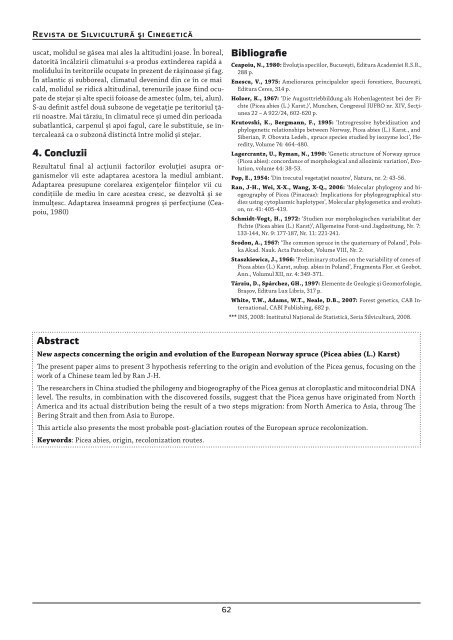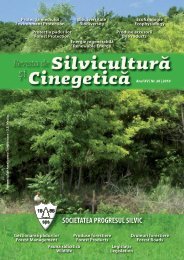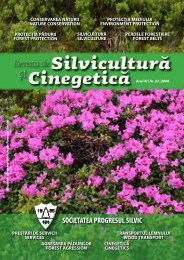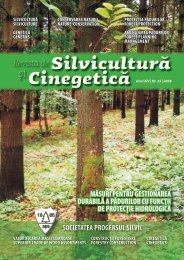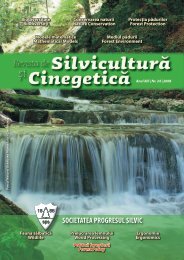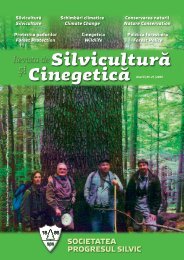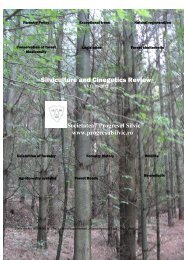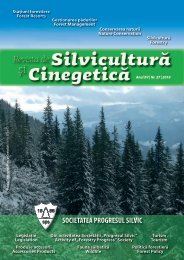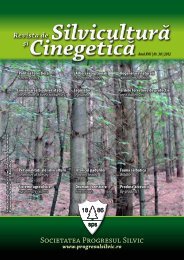Revista revistelor - Societatea Progresul Silvic
Revista revistelor - Societatea Progresul Silvic
Revista revistelor - Societatea Progresul Silvic
- No tags were found...
Create successful ePaper yourself
Turn your PDF publications into a flip-book with our unique Google optimized e-Paper software.
<strong>Revista</strong> de <strong>Silvic</strong>ultură şi Cinegeticăuscat, molidul se găsea mai ales la altitudini joase. În boreal,datorită încălzirii climatului s-a produs extinderea rapidă amolidului în teritoriile ocupate în prezent de răşinoase şi fag.În atlantic şi subboreal, climatul devenind din ce în ce maicald, molidul se ridică altitudinal, terenurile joase fiind ocupatede stejar şi alte specii foioase de amestec (ulm, tei, alun).S-au definit astfel două subzone de vegetaţie pe teritoriul ţăriinoastre. Mai târziu, în climatul rece şi umed din perioadasubatlantică, carpenul şi apoi fagul, care le substituie, se intercaleazăca o subzonă distinctă între molid şi stejar.4. ConcluziiRezultatul final al acţiunii factorilor evoluţiei asupra organismelorvii este adaptarea acestora la mediul ambiant.Adaptarea presupune corelarea exigenţelor fiinţelor vii cucondiţiile de mediu în care acestea cresc, se dezvoltă şi seînmulţesc. Adaptarea înseamnă progres şi perfecţiune (Ceapoiu,1980)BibliografieCeapoiu, N., 1980: Evoluţia speciilor, Bucureşti, Editura Academiei R.S.R.,288 p.Enescu, V., 1975: Ameliorarea principalelor specii forestiere, Bucureşti,Editura Ceres, 314 p.Holzer, K., 1967: ‘Die Augusttriebbildung als Hohenlagentest bei der Fichte(Picea abies (L.) Karst.)’, Munchen, Congresul IUFRO nr. XIV, Secţiunea22 – A 922/24, 602-620 p.Krutovski, K., Bergmann, F., 1995: ‘Introgressive hybridization andphylogenetic relationships between Norway, Picea abies (L.) Karst., andSiberian, P. Obovata Ledeb., spruce species studied by isozyme loci’, Heredity,Volume 74: 464-480.Lagercrantz, U., Ryman, N., 1990: ‘Genetic structure of Norway spruce(Picea abies): concordance of morphological and allozimic variation’, Evolution,volume 44: 38-53.Pop, E., 1954: ‘Din trecutul vegetaţiei noastre’, Natura, nr. 2: 43-56.Ran, J-H., Wei, X-X., Wang, X-Q., 2006: ‘Molecular phylogeny and biogeographyof Picea (Pinaceae): Implications for phylogeographical studiesusing cytoplasmic haplotypes’, Molecular phylogenetics and evolution,nr. 41: 405-419.Schmidt-Vogt, H., 1972: ‘Studien zur morphologischen variabilitat derFichte (Picea abies (L.) Karst)’, Allgemeine Forst-und Jagdzeitung, Nr. 7:133-144, Nr. 9: 177-187, Nr. 11: 221-241.Srodon, A., 1967: ‘The common spruce in the quaternary of Poland’, PolskaAkad. Nauk. Acta Pateobot, Volume VIII, Nr. 2.Staszkiewicz, J., 1966: ‘Preliminary studies on the variability of cones ofPicea abies (L.) Karst, subsp. abies in Poland’, Fragmenta Flor. et Geobot.Ann., Volumul XII, nr. 4: 349-371.Târziu, D., Spârchez, GH., 1997: Elemente de Geologie şi Geomorfologie,Braşov, Editura Lux Libris, 317 p.White, T.W., Adams, W.T., Neale, D.B., 2007: Forest genetics, CAB International,CABI Publishing, 682 p.*** INS, 2008: Institutul Naţional de Statistică, Seria <strong>Silvic</strong>ultură, 2008.AbstractNew aspects concerning the origin and evolution of the European Norway spruce (Picea abies (L.) Karst)The present paper aims to present 3 hypothesis referring to the origin and evolution of the Picea genus, focusing on thework of a Chinese team led by Ran J-H.The researchers in China studied the philogeny and biogeography of the Picea genus at cloroplastic and mitocondrial DNAlevel. The results, in combination with the discovered fossils, suggest that the Picea genus have originated from NorthAmerica and its actual distribution being the result of a two steps migration: from North America to Asia, throug TheBering Strait and then from Asia to Europe.This article also presents the most probable post-glaciation routes of the European spruce recolonization.Keywords: Picea abies, origin, recolonization routes.62


